Sports
Why drafting a successful NFL quarterback remains 'an inexact science'

The NFL franchise quarterback — the highly coveted symbol of hope, cornerstone of championship aspirations, difference between irrelevance and immortality — is also the rarest of breeds.
Don’t call it tanking, but desperate organizations abandon win-at-all-cost principles with the goal of landing an elite passing prospect with one of the top picks in the NFL Draft. Other quarterback-needy teams routinely mortgage future resources to improve draft positioning. But despite NFL decision-makers’ robust resumes as talent evaluators and extensive research — countless hours of game film, interviews and a gamut of measurables and grading tools — drafting a franchise quarterback remains one of the most challenging exercises they will ever execute.
“We all evaluated Tom Brady wrong when New England drafted him in the sixth round, and he’s turned out to be one of the best players — not just the best quarterback — the National Football League has ever seen,” Atlanta Falcons coach Raheem Morris said. “So it is continuously an issue for everybody. … We know those things that you go out and try to find, but it’s just a hard position to evaluate.”
On Thursday, teams will draft the next crop of projected franchise saviors. But these pivotal selections essentially amount to educated guesses about a position often described as the hardest to play in all of professional sports.
In the modern era of the NFL Draft (since 1967), 130 quarterbacks have been selected in the first round. Only 61 of those (46.9 percent) have won a playoff game as a starter, according to NFL Research, and just 58 of those quarterbacks (44.6 percent) have garnered Pro Bowl honors. Just 13 (8.1 percent) won a Super Bowl as a starter, and two of those didn’t even win their Super Bowls for their original teams.
Projecting quarterback talent poses such a challenge, in part, because of the differences between the college and pro games. Yes, college prospects play the same position. But transitions rarely prove seamless because college offenses and the defenses they face differ so greatly from those on a professional level.
“Just because you’re good at algebra, does that mean you’re good at calculus?” Miami Dolphins coach Mike McDaniel asked. “College football is a different game that has overlapping variables, but it’d be far-fetched to say at any position collegiate success dictates professional success.
“It’s a different orchestration of an 11-person game, and there’s different nuances to it. … And that’s why it’s an inexact science, because the success of the quarterback in the collegiate platform is based upon compounding variables that you have to sift through.”
College and professional football are played with different spacing thanks to different hash mark alignments. In college, the chalk markings that indicate where the ball will be snapped are 40 feet apart. In the NFL, that distance is just 18 feet, 6 inches, meaning the ball is nearer the center of the gridiron. It’s easier to scheme receivers open in college while NFL passing windows are much tighter thanks to narrower hash marks and faster defenders. All of that requires faster decision-making and greater accuracy.
“We’ve got draft picks at every position,” said Jacksonville Jaguars head coach Doug Pederson, a former NFL quarterback himself. “So space and time — the speed element — plays a big factor.”
It takes time for rookies at any position to adjust to that faster-paced game. Then throw in the responsibilities heaped on a quarterback: running a huddle, maybe for the first time (most colleges utilize no-huddle offenses), reading more complex defensive coverages and making protection and play-call changes at the line of scrimmage.
“The amount of information he has to process in such a limited amount of time, all the leadership stuff and intangible stuff … there’s a certain amount of athletic gifts and talent you have to have, and then there’s so much more beyond that,” said Green Bay Packers GM Brian Gutekunst. “And I think the thing that is lost at times is how much of it has to be developed over time.”
NFL coaches and scouts must use their imaginations while studying a prospect to grasp his ability to make that leap.
“You turn on the (college) tape and you’re seeing certain successful, explosive offensive teams that are putting up a ton of points,” Minnesota Vikings coach Kevin O’Connell said. “But you’re trying to figure out if This play right here; this third-down play — does this translate to what we’re going to ask him to do in our offense? … You try to find the traits first, and then go back and apply those traits to (prospects) doing certain things that maybe they don’t even know they’re doing at the time.”
Of course, there are quarterbacks who excel at executing elements of the pro game despite never having displayed such an ability in college. C.J. Stroud, 2023 Offensive Rookie of the Year, played at a top-five level his first year while executing a Houston Texans offense whose concepts and responsibilities differed vastly from the system he ran at Ohio State.
The speed, elusiveness and athleticism Lamar Jackson displayed at Louisville made him a lock to terrorize NFL defenses as a runner, but Jackson faced doubts about his passing ability because many NFL scouts didn’t see many NFL-type throws during evaluations. In six pro seasons with the Baltimore Ravens, Jackson has twice won MVP — including after last season — while being among the league leaders in passer rating.
“We’re only getting to see who a player is right now in college at 21, 22 years old. … It’s a complete projection on who can be better,” Hall of Fame quarterback Kurt Warner said. “We’ve all seen guys who were average college quarterbacks — and you could probably include myself — that become better and great at the next level. … And we’ve all seen other quarterbacks who were great college quarterbacks that never got any better and disappeared in the NFL.
“We throw out, ‘Well, man, their ceiling is so high when they put it all together.’ But we don’t really know what somebody’s ceiling is until they get there or they get close to it. … I also believe that the ceiling for guys is more mental than it is physical, and that’s really hard to truly test.”
Not that NFL teams don’t try, investing in evaluation tools like the Wonderlic and S2 cognition tests in hopes of grasping a quarterback’s intelligence or processing speed. Stroud called into question the S2 test’s credibility last season after his low score leaked and caused some NFL analysts to question his ability to succeed as a pro. The unfazed Texans took Stroud second overall, and he led Houston to the AFC South title after throwing 23 touchdown passes and just five interceptions.
GO DEEPER
What did NFL learn about S2 after CJ Stroud? ‘People in our league can’t help themselves’
And that’s why some coaches insist cognitive tests can’t reflect competency the same way that on-field execution and face-to-face X’s and O’s discussions do.
“I know those are all good metrics to go off of — and how players learn and when they process and all that,” Pederson said. “But to me, the bottom line is you’ve got to go spend time with these guys.”
That’s no guarantee, either.
Heading into the 2007 draft, JaMarcus Russell had IT. The 6-foot-6, 256-pound LSU star dwarfed most quarterbacks, even some linemen. And he had a winning pedigree, leading the Tigers to top-10 finishes in his sophomore and junior seasons.
He dazzled during his pro day in front of the 100-plus NFL talent evaluators in Baton Rouge, with the football exploding out of his hand. His 40-yard dash time (4.84 seconds) topped some players a fraction of his size. Some NFL analysts described Russell’s pro day as the best they had ever seen. The Oakland Raiders fell in love and took him first overall three months later.
Three years later, Russell was out of the NFL, never to return.
Blinded by Russell’s marvelous physical gifts, the Raiders had missed red flags. A lengthy contract holdout retarded his development process, and a poor work ethic and problems with substance abuse ensured him a label as one of biggest busts in NFL draft history — and a cautionary tale about the dangers of falling in love with a player based on his pro day performance.
But Russell wasn’t the first player to inflate his draft status with a wondrous workout. Nor was he the last.
Illinois’ Jeff George shined at his 1990 pro day, convincing the Indianapolis Colts to draft him first overall and award him a $15 million contract, an astounding figure for that day. Strong-armed but erratic and undisciplined, George ultimately developed into a journeyman with a 37.1 winning percentage as a starter and 1-2 playoff record.
Zach Wilson’s performance at his pro day in 2021 sparked comparisons to Aaron Rodgers, and the New York Jets took the former BYU star second overall. But Wilson proved unable to adjust to the massive leap in the level of competition, and a poor developmental plan around him ultimately doomed his prospects. The Jets this week essentially gave him to the Denver Broncos for a swap of late-round picks.

Ryan Leaf washed out after parts of three NFL seasons in San Diego and Dallas (Getty Images)
Pro day workouts can certainly inspire NFL decision-makers, but they emphasize physical gifts and not poise, focus, grit and determination — the traits that define great quarterbacks. Mike Tyson once famously said, “Everyone has a plan until they get punched in the mouth.” The same applies to NFL quarterbacks, just replace the punch with a 6-foot-7, 280-pound pass-rusher with track-star speed. Or an All-Pro safety with better ball skills than most college wide receivers. Or a coach or teammate berating them on the sideline for making a mistake.
Great quarterbacks elevate in times of apparent crisis.
“The franchise quarterback is someone you can win because of, rather than just with,” said longtime NFL agent Leigh Steinberg, whose client list includes Patrick Mahomes, Troy Aikman, Steve Young and Warren Moon. “The critical distinction is the quarterback who can have thrown a couple interceptions — the crowd is booing, the game’s getting out of hand, what does he do now?
“A franchise quarterback is someone who can compartmentalize, adopt a quiet mind, filter out past mistakes and elevate his level of play in critical circumstances to take a team to and through victory.”
Gauging a quarterback’s ability to handle adversity is hard, NFL coaches say, because few prospects — most of them the brightest and best athletes on their teams since grade school — have encountered anything in life like the pressure and defeats they will experience in the NFL.
“Some cases, you never really know until you have that time to try to develop a guy,” Gutekunst said.
Steinberg points to the differences in mental makeup that wound up defining the careers of Peyton Manning and Ryan Leaf. In 1998, Steinberg recruited and signed Leaf because the Washington State star possessed greater physical gifts and more impressive measurables than Tennessee’s Manning, who went No. 1 to the Indianapolis Colts.
“Ryan Leaf, physically, was the better quarterback than Peyton Manning,” Steinberg said. “But Peyton Manning had the killer mentality and attention to detail, so Ryan missed that.”
After being selected second by the San Diego Chargers, Leaf played portions of only three NFL seasons, went 4-17 as a starter and threw just 14 touchdown passes against 36 interceptions while getting sacked 65 times.
“In adversity, Ryan Leaf receded and became more isolated and felt embarrassed,” Steinberg said. “He started out very fast in training camp and first couple preseason games, but when he hit a (regular-season) game, then he went into a shell, and the best in terms of therapists and everything else couldn’t get him back out.”
NFL coaches and general managers struggle to explain how to identify the intangibles that forge a quarterback for greatness. But a tireless work ethic, an approach to film study that borders on maniacal and obsessed, displays of strong leadership and respect for the game tend to shine through.
“You’ve got to spend time with him and get to know him a bit and try to give them different things and put them in different situations as much as you can,” Kansas City Chiefs coach Andy Reid said at the NFL Scouting Combine. “You do it while in environments like this. You visit him at college campuses or have them come with us. It’s you talking to their coaches and then talking to the players around them.”
Said Washington Commanders general manager Adam Peters, “I’ve always found in scouting that you make the biggest mistakes more so on the person than the actual talent.”
Plenty of disappointing quarterback prospects have received more blame for their failure to blossom than they should have. Some failed because they landed in environments that gave them little chance for success.
Stanford’s Andrew Luck and Baylor’s Robert Griffin III, the first two picks of the 2012 draft, were supposed to transform Indianapolis and Washington into perennial contenders, respectively. But Luck’s poor supporting cast — especially along the Colts’ offensive line — led to his stunning retirement six years later. And dysfunction largely ruined Griffin’s promising career in Washington.
The Colts essentially committed malpractice through negligence. Frugal free agency spending, poor drafts and the repeated refusal to upgrade a weak line placed Luck in ever-present risk of serious injury. By the time his career abruptly concluded, the quarterback’s gauntlet of serious injuries included a high-ankle sprain, calf strain, abdominal muscle tear, lacerated kidney, concussion and torn labrum in his shoulder.
Meanwhile, Griffin landed with a franchise mired in turmoil. Then-owner Daniel Snyder undermined then-coach Mike Shanahan and poisoned the relationship between quarterback and coach. Griffin managed to put up a historic rookie season before suffering a knee injury that required reconstructive surgery. Then, desperate to save his job, Shanahan allowed Griffin to rush back in 2013. Griffin regressed while backup Kirk Cousins ascended, causing a quarterback controversy. Shanahan was fired at the end of the season. Griffin never recaptured his magic.

GO DEEPER
How does the greatest QB prospect since Elway walk away before he’s 30? Inside ‘Luck’
Organizational alignment, a clear development plan and quality teammates are among the must-haves for quarterback success. New England discovered Brady and developed him into a future Hall of Famer who delivered six Lombardi Trophies and 20 years of stability. Kansas City is the league’s latest dynasty with Mahomes as the centerpiece thanks to similar top-to-bottom alignment and a carefully planned quarterback development plan.
“There’s a lot of things that go into that,” Reid said. “Where’s the staff at? Are they in their last year, are they in their first year? What offense are you asking this guy to be in? Will it work with his strengths and will you try to better the things that he’s not as strong at, weaknesses? Are you willing to stand before (reporters) and kind of protect that guy so he can grow a little bit?”
In each case when he groomed a top young quarterback, Reid exercised patience. In Philadelphia, Donovan McNabb backed up Pederson after being selected second overall in 1999, playing only sparingly until Week 10, when Reid felt comfortable enough to turn the reins over. Perhaps it’s no coincidence that of the four quarterbacks picked in the first round that year, only McNabb and Minnesota’s Daunte Culpepper, who also sat initially, became effective starters. Draft mates Tim Couch and Akili Smith, who played before they were ready, were deemed busts.
In Kansas City, Mahomes sat behind Alex Smith on a playoff team for a year before becoming the starter. Three Super Bowls and two MVP honors later …
Steinberg believes public displays of patience and sincere acts of support are crucial to a quarterback’s development. He pointed to the friction and public arguments between Leaf and then-Chargers general manager Bobby Beathard during the quarterback’s bad stretches of play and noted the contrast between then-Colts GM Bill Polian’s repeated proclamations of support for Manning despite his leading the NFL in interceptions as a rookie.
“It is a combination of scouting and development skills,” Steinberg said. “All the quarterbacks that haven’t made it, they can’t all have been bad draft picks. They just can’t. Drafting and the evaluation process is way too thorough.”
Understanding the need for time and development at the position, the Packers have repeatedly drafted quarterbacks before their starter’s play drops off, so coaches don’t feel the pressure to rush a young prospect on the field prematurely. As a result, Green Bay has had relatively clear succession plans from Brett Favre to Rodgers to Jordan Love, leading to stability for three decades.
But the Packers are the outliers. Troubled organizations are most often the ones in need of franchise savior. The desperation for transformational talent — both to contend and to save jobs — clouds judgment and leads to mind-blowing blunders, sometimes when warning signs are right there.
In 2021, Zach Wilson went to the Jets second overall with no clear development plan despite the leap in competition level. North Dakota State’s Trey Lance was a project player who San Francisco punted on just two seasons after giving up three first-round picks to move up to No. 3 to select him. Ohio State’s Justin Fields, Chicago’s pick at No. 11, played behind horrendous lines and for coaches and coordinators who never displayed a firm grasp of his strengths and weaknesses. And Mac Jones went 15th to quarterback-needy New England when most rival scouts had a third-round grade on him.
After Wilson’s trade to Denver this week, none of the four is on the roster of the team that drafted him.
The Bears have used 36 different starting quarterbacks since Favre first suited up for Green Bay. In 2017, they traded up to draft Mitch Trubisky (now a journeyman backup) over Mahomes. Five years later, they drafted Fields. Now, after moving on from Fields this offseason, Chicago is expected to take Caleb Williams first overall with hopes that this time things will be different.
(Illustration: Eamonn Dalton / The Athletic; photos: Jordon Kelly, Kevin Sabitus / Getty Images)

Sports
Mystik Dan wins 150th Kentucky Derby in photo finish
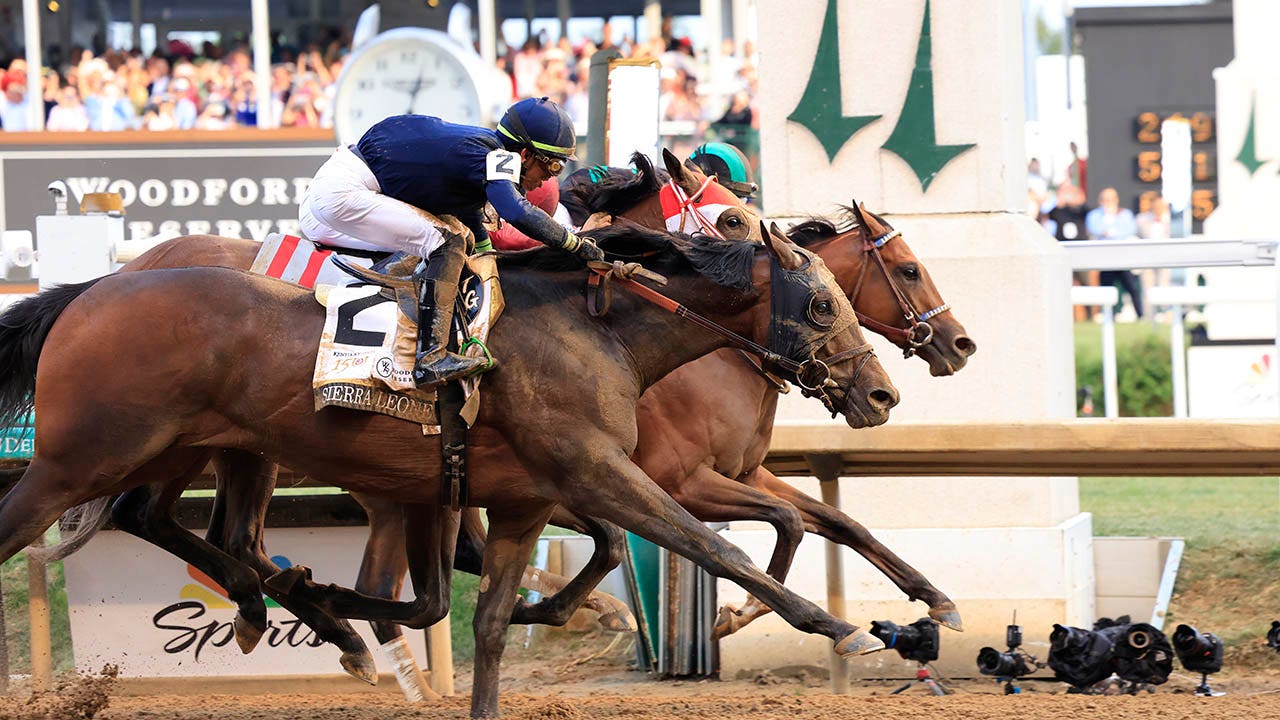
Mystik Dan (18-1) won the 150th Kentucky Derby Saturday in a photo finish.
It was the first time in 28 years the Kentucky Derby was won by a nose and just the 10th time ever.
Track Phantom (41-1) and Just Steel (21-1) led up until the ¾-mile mark, with Fierceness, the 3-1 favorite, in third. Mystik Dan, though, held the inside right behind them.
Mystik Dan, ridden by jockey Brian J. Hernandez Jr., crosses the finish line to win the 150th Kentucky Derby at Churchill Downs May 4, 2024, in Louisville, Ky. (Justin Casterline/Getty Images)
Mystik Dan, ridden by Brian Hernandez Jr., busted through the pack after the final turn. After the turn, Fierceness fell way behind.
Mystik Dan led by several lengths in the final stretch, but Sierra Leone (9-2), the second-highest favorite, crept up from the outside, pushing Japanese horse Forever Young toward the railing.
Those three horses were within noses of each other, but it was Mystik Dan’s that crossed the line first.
Sierra Leone finished second and Forever Young finished third, while Fierceness finished 15th, 24½ lengths behind.
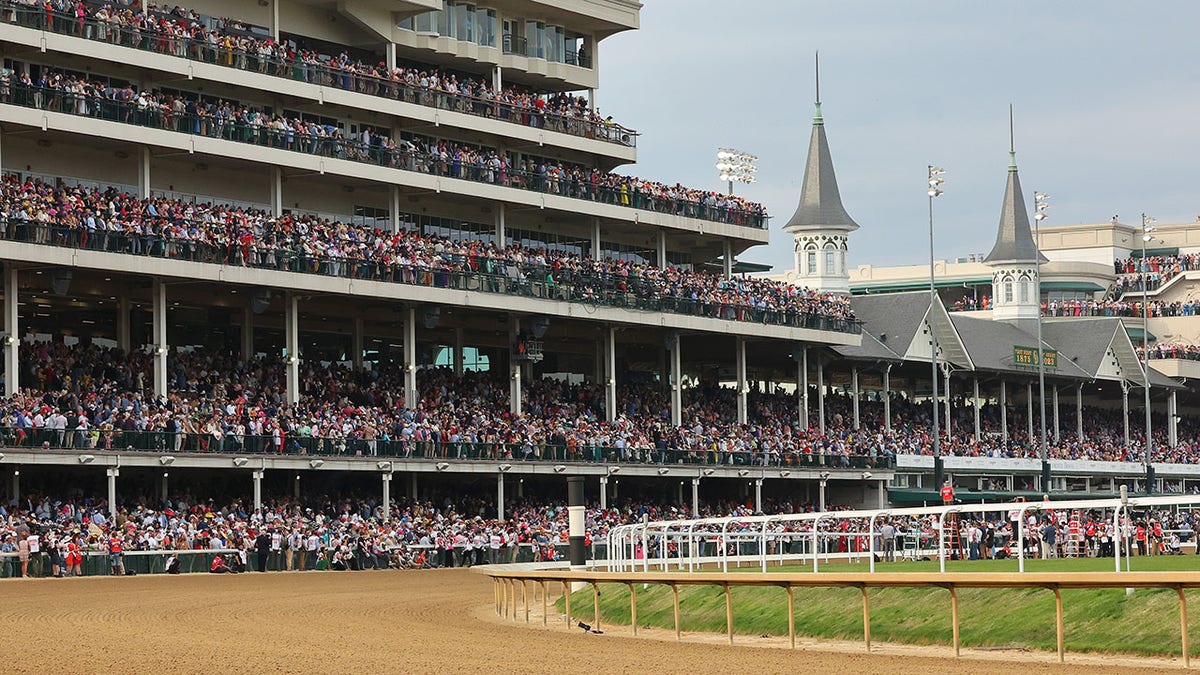
A general view of Churchill Downs ahead of the 149th running of the Kentucky Derby May 6, 2023, in Louisville, Ky. (Michael Reaves/Getty Images)
This year’s race came with much less controversy than last year’s. A dozen horses died at Churchill Downs in the days, and even hours, leading up to last year’s race.
Notably absent from this year’s race was Hall of Fame trainer Bob Baffert, who’s two-year ban was extended through 2024, making this the third straight Kentucky Derby a Baffert-trained horse did not compete.
A six-time winner at the Derby, Baffert was banned after 2021 Kentucky Derby winner Medina Spirit was stripped of the title due to a failed post-race drug test. The horse died of a heart attack that December.

Visitors check out the new $200 million paddock at Churchill Downs Wednesday, May 1, 2024, in Louisville, Ky. (AP Photo/Charlie Riedel)
Mystik Dan will now begin the quest for a Triple Crown at the Preakness Stakes at Baltimore’s Pimlico Race Course May 18.
Follow Fox News Digital’s sports coverage on X, and subscribe to the Fox News Sports Huddle newsletter.
Sports
Sondheimer: Jonas Meskis is living the teenage dream of international surfer
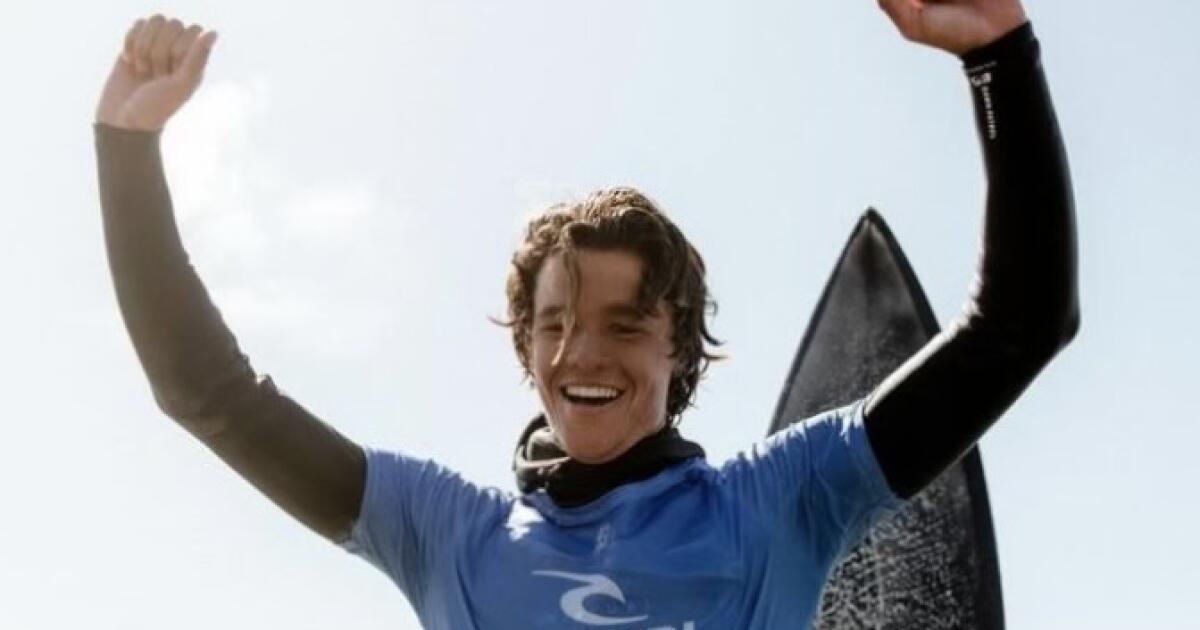
Jonas Meskis, 17, acts like every day is a good day.
“I’m living the good life,” he says. “It’s incredible.”
He’s a surfer traveling the world and visiting surfing hot spots with his twin brother, Jackson.
“Oh my gosh, it’s incredible. It’s so cool,” Jonas says.
This weekend Jonas is in Surf City, El Salvador, competing at the ISA World Junior Surfing Championship. Last month he was in British Columbia winning the Canadian junior national championship.
He’s got his own YouTube channel. He’s an influencer on TikTok and Instagram. He has an endorsement deal from a French wetsuit maker and another for Sun Mud sunscreen. He’s enrolled in an independent study program through Oak Park Independent School, leaving time for surfing in the morning or whenever.
“It’s great, all fun,” he says.
His father, Jason, is assistant principal at Oak Park High. His mother works for the school district. His brother didn’t qualify to compete in El Salvador but joins Jonas as a morning surfing partner for trips to Zuma Beach or Ventura Harbor.
Jonas says nothing produces a better adrenaline rush than riding a wave and nothing is more relaxing than sitting on a board in the middle of the ocean.
“It’s pretty cool. You’re putting yourself in a dangerous situation a lot of people couldn’t handle,” he says. “I love it so much. I like how it separates me from the regular world. I’m going to a whole different environment. I get to clear my mind. No wave is the same. It’s always new, it’s always changing.”
Jonas talks like an A student, which he is. The stereotype of surfers not being the brightest (think “Fast Times at Ridgemont High”) just doesn’t fit. He does embrace all the surfer phrases, though. He’s got the lingo down to perfection.
Moorpark resident Jonas Meskis is surfing at the World Championships in El Salvador this week.
(Jayden Beedie)
“You’re shredding” means surfing is good.
“Sick” means awesome.
“Gnarly” means large.
Surf competitions come down to finding a big wave, riding it and impressing the judges. Winning the Canadian junior championship was important to Jonas. His parents and many relatives are Canadian.
“I was so happy. I worked so hard the past three years to win that,” he said.
His parents have supported the twins by paying for trips, but Jonas works during the summer giving surfing lessons. The twins intend to enroll at Moorpark College after high school.

Teenage surfer Jonas Meskis is in El Salvador this week as part of the World Championships.
(Meskis family)
For now, Jonas is obeying a strict surfing schedule.
He started a streak of surfing every day and keeping his fans informed via social media. The streak reached 144 days Saturday, even after storms came to Southern California and made going into the water unhealthy. He brought out earplugs and a hood to wear with his wetsuit and took long showers afterward to avoid getting sick.
He has visited Mexico, Brazil and Costa Rica to surf. How long he keeps competing remains to be seen. But he makes clear his love for surfing will never end.
“I don’t know how far I want to take it competitively, but I know for a fact I’ll always be surfing,” he said.
As they say in surfing lingo, that’s sick.
Sports
Tyronn Lue says it's 'great to be wanted' amid Lakers speculation; he's focused on coaching Clippers
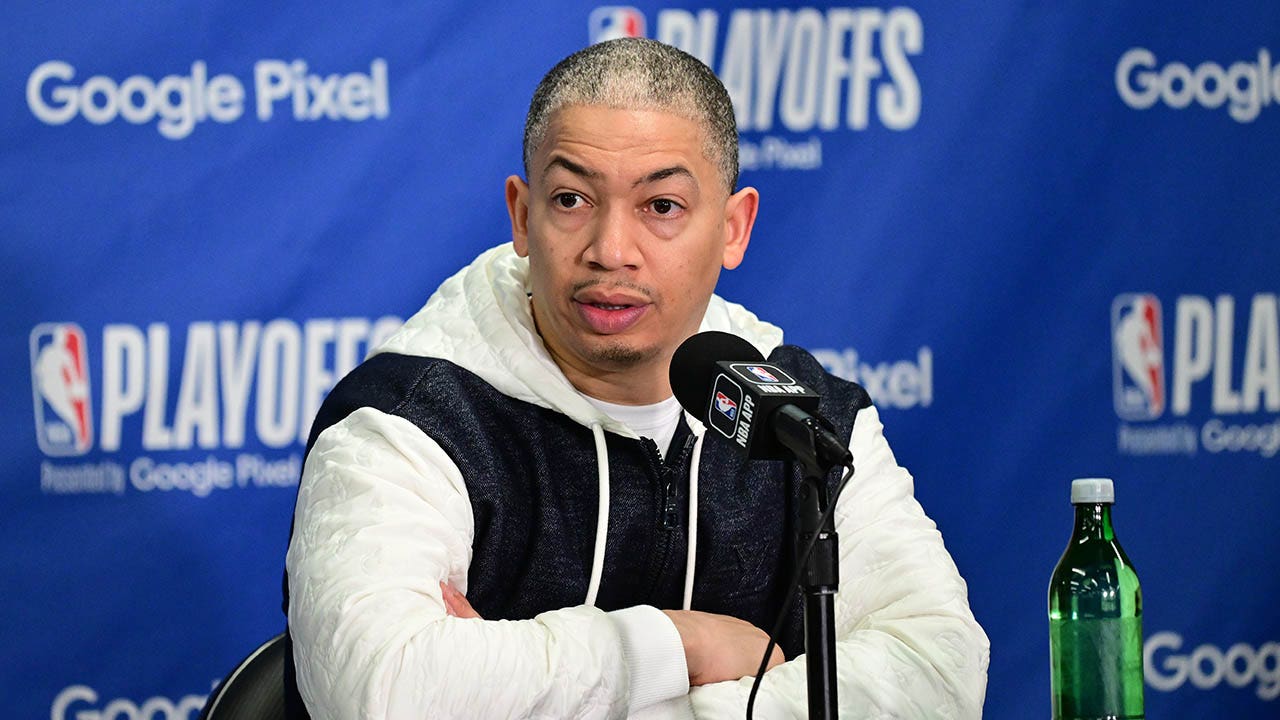
NBA champion head coach Tyronn Lue remains focused on his future with the Los Angeles Clippers — not the Los Angeles Lakers.
The Clippers were eliminated from the NBA playoffs after the team lost 114-101 to the Dallas Mavericks May 3.
According to The Athletic, the Clippers plan to pursue a contract extension with Lue this offseason. After Friday’s loss, Lue was asked whether he expected to remain with the Clippers.
Head coach Tyronn Lue of the LA Clippers talks to the media after Game 1 of the first round of the 2024 NBA Playoffs against the Dallas Mavericks April 21, 2024, at Crypto.com Arena in Los Angeles. (Adam Pantozzi/NBAE via Getty Images)
“I hope so. … You know, I hope so. I didn’t come here to bounce around and go all over the place,” Lue, who turned 47 Friday, said.
BLAKE GRIFFIN ANNOUNCES RETIREMENT FROM NBA AFTER LONG CAREER
The coach also spoke about his strong relationship with Clippers ownership and the front office.
“Mr. Ballmer, Lawrence (Frank, president of basketball operations), Mark Hughes (assistant general manger), Trent (Redden, general manager), Gillian (Zucker, president of business operations) … they’ve all been great to me. This is where I want to be, and hopefully they feel the same way. I haven’t had a better experience since I’ve been here. Mr. Ballmer showed me a lot of different things that I wouldn’t be privy to if I wasn’t here.”
Lue declined to directly address speculation the Lakers would target him in their search after firing Darvin Ham.
“I don’t really have a comment on that,” Lue said when asked about his name surfacing in the Lakers’ search. “It’s great to be wanted. That’s a really good feeling. Like I said, I want to be here. Hopefully, we’re able to solidify that.”

LA Clippers head coach Ty Lue in the first quarter against the Indiana Pacers at Gainbridge Fieldhouse in Indianapolis Dec. 31, 2022. (Trevor Ruszkowski/USA Today Sports)
Lue has two years remaining on his contract.
The Clippers were without star forward Kawhi Leonard in four of the six games against the Mavericks due to his right knee inflammation. He missed three of five games in a first-round loss to Phoenix last year.
“I give our guys credit for just sticking with it through all the ups and downs and all the negative scrutiny and all the things that they went through this season,” Lue said. “Having to go into a series again short-handed.”
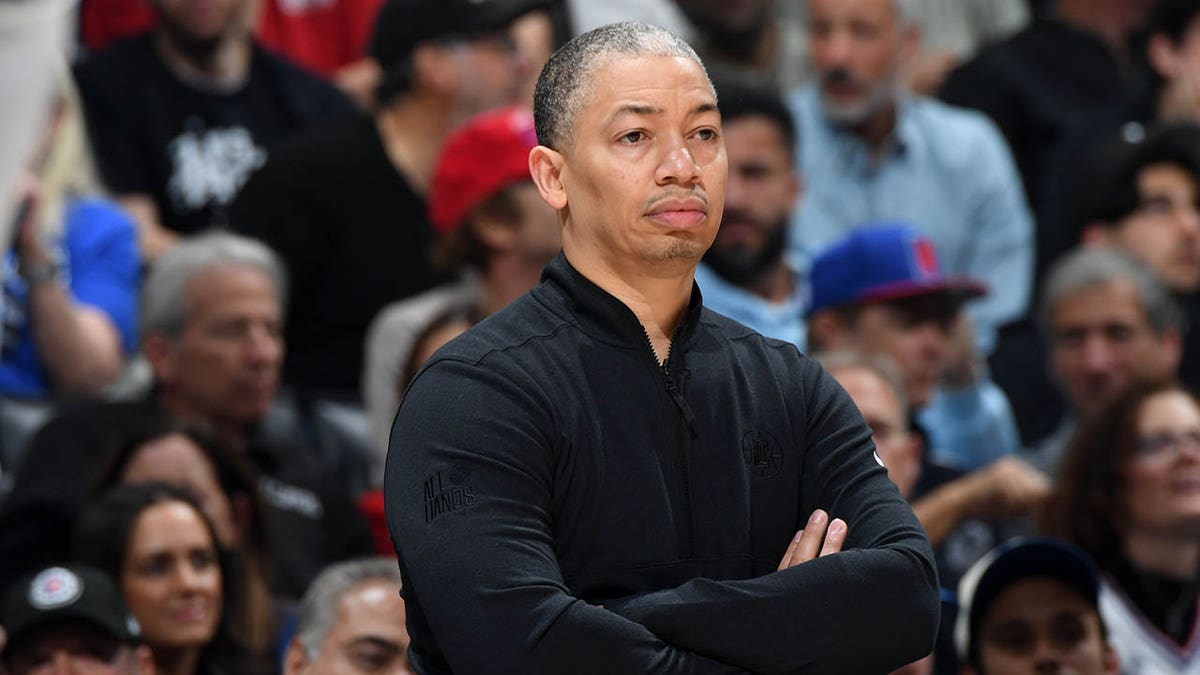
Tyronn Lue of the LA Clippers during Game 2 of the first round of the 2024 NBA Playoffs against the Dallas Mavericks April 23, 2024, at Crypto.com Arena in Los Angeles. (Andrew D. Bernstein/NBAE via Getty Images)
Lue coached Cleveland to the 2016 NBA title with LeBron James, who left for the Lakers in free agency two years later. Lue was gone just six games — all losses — into the season after James’ departure from the Cavaliers.
Lue was an assistant on Doc Rivers’ staff with the Clippers before taking over when Rivers and the club mutually parted ways following the 2019-20 season. Rivers ended up in Philadelphia.
The Clippers reached the Western Conference finals in Lue’s first season and have a 184-134 record in the regular season under him.
“This was a good year,” Lue said. “Overall, I wouldn’t trade it for anything, outside the early ending. I like the guys in the locker room. They respect me. I respect them. I’m ready to move on to next season and get better.”
The Associated Press contributed to this report.
Follow Fox News Digital’s sports coverage on X, and subscribe to the Fox News Sports Huddle newsletter.
-

 News1 week ago
News1 week agoFirst cargo ship passes through new channel since Baltimore bridge collapse
-

 World1 week ago
World1 week agoHaiti Prime Minister Ariel Henry resigns, transitional council takes power
-

 Movie Reviews1 week ago
Movie Reviews1 week agoAbigail Movie Review: When pirouettes turn perilous
-

 World1 week ago
World1 week agoEU Parliament leaders recall term's highs and lows at last sitting
-

 Politics1 week ago
Politics1 week ago911 call transcript details Democratic Minnesota state senator’s alleged burglary at stepmother's home
-

 Politics1 week ago
Politics1 week agoGOP lawmakers demand major donors pull funding from Columbia over 'antisemitic incidents'
-

 Science1 week ago
Science1 week agoOpinion: America's 'big glass' dominance hangs on the fate of two powerful new telescopes
-

 World1 week ago
World1 week agoHamas ‘serious’ about captives’ release but not without Gaza ceasefire



















